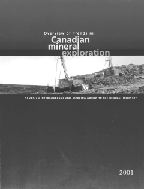A survey of mineral exploration, deposit appraisal and mine development spending predicts that exploration and appraisal spending for 2001 will dip to a historical low of $458 million, a far cry from the $921 million spent in 1997.
The prediction is included in Overview of Trends in Canadian Mineral Exploration, compiled by an inter-governmental working group on the nation’s mineral industry.
The biggest drop occurred in 1998, when spending fell $265 million to $656 million. The trend continued in 1999 and 2000, when spending slipped to $504 million and $473 million, respectively.
Federal and provincial governments have reacted to the situation by introducing flow-through share programs, designed to boost exploration spending.
Meanwhile, Canada’s grassroots exploration sector has stabilized after expenditures declined by almost 50% between 1997 and 1999. Junior mining companies accounted for $149 million in spending in 2000, compared with $325 million spent by seniors. In 2001, spending is forecast to be $167 million.
Precious and base metals continue to be the most sought-after commodity groups in Canada despite a continuation of the downward trends in spending in these categories.
Spending on the search for diamonds, however, will remain at the $100-million level. More money is being invested in advanced work aimed at bringing existing diamond projects into production.
Globally, Canada’s position as one of the world’s top mineral exploration targets improved in 2000, when it garnered nearly 14% of the exploration budgets of the world’s larger exploration and mining companies, compared with about 11% in each of the previous three years.
Also in 2000, Canadian companies conducted mineral exploration programs valued at roughly $900 million, an amount equivalent to 30% of all the activity planned worldwide.


Be the first to comment on "Exploration spending continues slide"